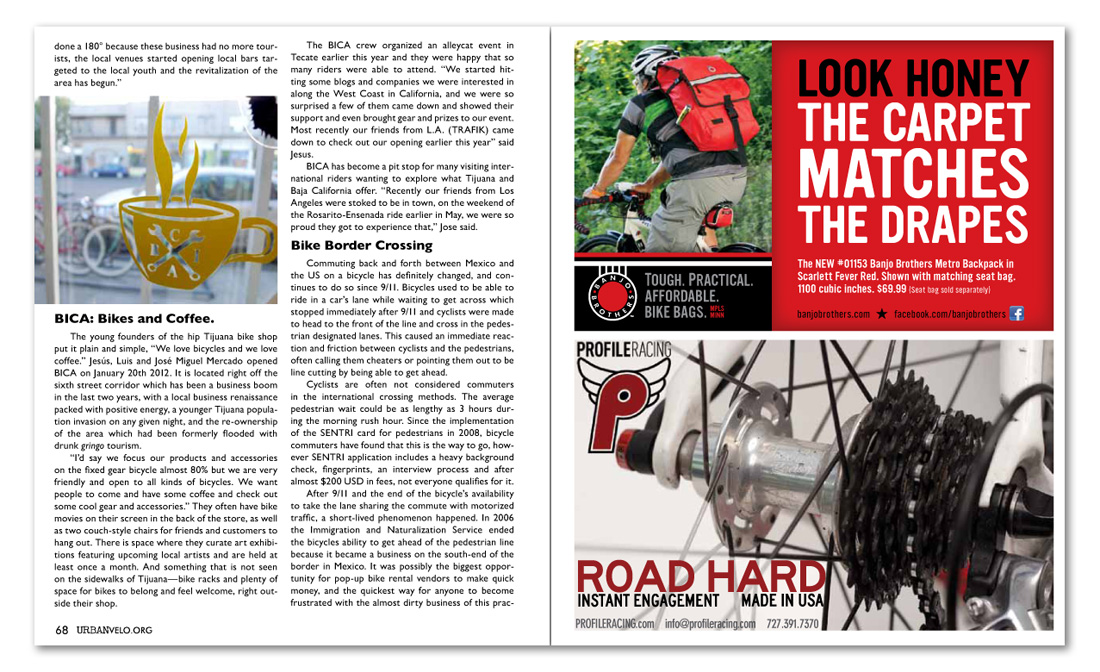


done a 180° because these business had no more tourists, the local venues started opening local bars targeted to the local youth and the revitalization of the area has begun.”
BICA: Bikes and Coffee.
The young founders of the hip Tijuana bike shop put it plain and simple, “We love bicycles and we love coffee.” Jesús, Luis and José Miguel Mercado opened BICA on January 20th 2012. It is located right off the sixth street corridor which has been a business boom in the last two years, with a local business renaissance packed with positive energy, a younger Tijuana population invasion on any given night, and the re-ownership of the area which had been formerly flooded with drunk gringo tourism.
“I’d say we focus our products and accessories on the fixed gear bicycle almost 80% but we are very friendly and open to all kinds of bicycles. We want people to come and have some coffee and check out some cool gear and accessories.” They often have bike movies on their screen in the back of the store, as well as two couch-style chairs for friends and customers to hang out. There is space where they curate art exhibitions featuring upcoming local artists and are held at least once a month. And something that is not seen on the sidewalks of Tijuana—bike racks and plenty of space for bikes to belong and feel welcome, right outside their shop.
The BICA crew organized an alleycat event in Tecate earlier this year and they were happy that so many riders were able to attend. “We started hitting some blogs and companies we were interested in along the West Coast in California, and we were so surprised a few of them came down and showed their support and even brought gear and prizes to our event. Most recently our friends from L.A. (TRAFIK) came down to check out our opening earlier this year” said Jesus.
BICA has become a pit stop for many visiting international riders wanting to explore what Tijuana and Baja California offer. “Recently our friends from Los Angeles were stoked to be in town, on the weekend of the Rosarito-Ensenada ride earlier in May, we were so proud they got to experience that,” Jose said.
Bike Border Crossing
Commuting back and forth between Mexico and the US on a bicycle has definitely changed, and continues to do so since 9/11. Bicycles used to be able to ride in a car’s lane while waiting to get across which stopped immediately after 9/11 and cyclists were made to head to the front of the line and cross in the pedestrian designated lanes. This caused an immediate reaction and friction between cyclists and the pedestrians, often calling them cheaters or pointing them out to be line cutting by being able to get ahead.
Cyclists are often not considered commuters in the international crossing methods. The average pedestrian wait could be as lengthy as 3 hours during the morning rush hour. Since the implementation of the SENTRI card for pedestrians in 2008, bicycle commuters have found that this is the way to go, however SENTRI application includes a heavy background check, fingerprints, an interview process and after almost $200 USD in fees, not everyone qualifies for it.
After 9/11 and the end of the bicycle’s availability to take the lane sharing the commute with motorized traffic, a short-lived phenomenon happened. In 2006 the Immigration and Naturalization Service ended the bicycles ability to get ahead of the pedestrian line because it became a business on the south-end of the border in Mexico. It was possibly the biggest opportunity for pop-up bike rental vendors to make quick money, and the quickest way for anyone to become frustrated with the almost dirty business of this prac-
Banjo Brothers
Profile Racing